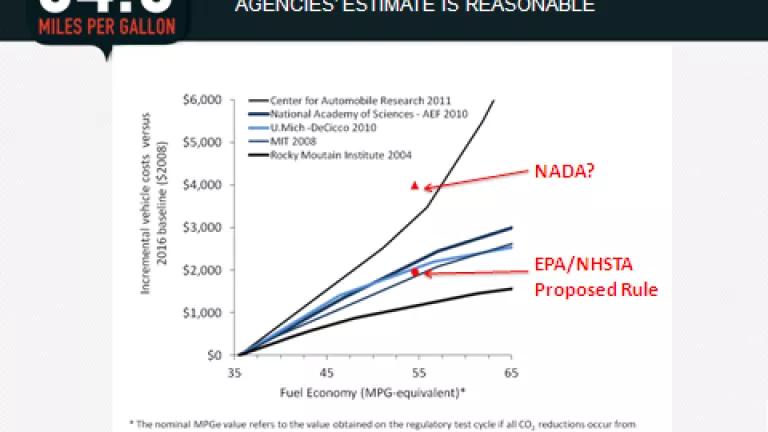
After last week’s public hearings on the 54.5 mpg proposal, it’s clear that National Auto Dealers Association (NADA) is isolated in its opposition. Even long time opponents of fuel efficiency standards, like Congressman Dingell, UAW, and GM, all are now firmly on board with stronger standards. Why? Because they know that the standards will keep America moving forward. Stronger standards will result in an investment of $0.5 trillion into our economy over the next 20 years, create 500,000 jobs and ensure the rebirth of the U.S. auto industry as leaders in advanced technologies.
Even the highly respected auto industry weekly Automotive News, implored NADA that it “must be reasonable about CAFE proposal”. The auto dealer industry itself is not of one mind, as evidenced by a number of auto dealers editorializing and testifying in support of the 54.5 mpg standard.
Unfortunately, the overwhelming support and pleas for reasonableness appear to continue to fall on deaf ears at NADA. Last week, NADA announced it will be shortly releasing a study that claims the standard will raise the cost of cars by $5,000. As shown below, NADA's cost claim is twice as high as not just the agencies' estimate but also results from other independent, peer-reviewed studies from the National Academy of Science, Massachusetts Institute of Technology, and University of Michigan.
My colleague, Simon Mui, in a previous blog carefully assessed the EPA’s and NHSTA’s cost estimates and found them to consistent and reasonable with the latest, most germane, peer-reviewed studies from the National Academy of Science, Massachusetts Institute of Technology, and University of Michigan, among others.
I’ve added the final EPA and NHSTA cost estimate of $1946 to Simon’s original chart and adjusted the NADA claim to reflect the same baseline year, model year 2016,. NADA has not released its study yet, but I’m assuming the $5,000 claim is using their preferred baseline cost comparison of today’s cars versus the 2016 average car. Therefore, I adjust the NADA cost by about $1,000 to reflect the difference between a 2012 and 2016 car. As shown in the chart, even when adjusted for same baseline year, the NADA estimate appears to be about twice as high as the agency’s estimate of $1,946.
What’s a bit surprising, it’s that (asuming my $4,000 “apples to apples” comparison is a correct interpretation of NADA's claim) NADA's claim is even higher than what the auto industry was claiming before the agreement. The auto industry was widely citing the Center for Automobile Research estimate last year but have since dropped reference to it. (See my previous blog critiquing the CAR estimate. In my colleague Simon Mui’s analysis, he corrected the CAR study for different baselines and treatment of air conditioning credits to come up with his "apples-to-apples" comparison chart.)
We fully support every stakeholder’s voices to be heard in this debate. Healthy debate makes for a better process and better policies. Virtually every important stakeholder – automakers, labor unions, consumer advocates and environmentalists – are all full agreement that our country should move forward, together, with the 54.5 mpg standard.
We are heartened that some auto dealers have the courage to break with their lobbying association. It’s time for NADA to be reasonable and join with environmentalist, automakers, labor, consumer groups, and others to keep America moving forward.